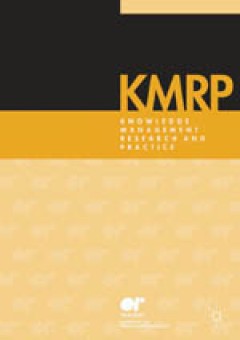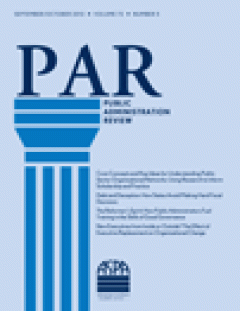Filter by

Junior researchers’ experience of innovation in a multidisciplinary team en…
This paper describes junior researchers� experience of innovative research, with the aim of encouraging fellow junior academics. Through the experience, the team recognised that context and flexibility are key factors in the research process. These factors are discussed in the light of three specific features of this project. First is the type of research the team engages in: meta-research, whi…
- Edition
- Vol. 9, No. 2, March 2011.pp.95–97
- ISBN/ISSN
- 14778238
- Collation
- -
- Series Title
- Knowledge Management Research & Practice
- Call Number
- -

Reflections on the Spirit and Work of the U.S. Advisory Commission on Intergo…
What did the U.S. Advisory Commission on Intergovernmental Relations (ACIR) accomplish before it was disbanded in 1996? Were its accomplishments sufficiently valuable to justify reestablishing the organization? This article reviews the commission�s origins, history, and accomplishments, and addresses future intergovernmental needs. The ACIR�s accomplishments were substantial, but are largely un…
- Edition
- Vol. 71, Issue 2, March/April 2011. pages 161–168
- ISBN/ISSN
- 00333352
- Collation
- -
- Series Title
- Public Administration Review
- Call Number
- -

An ACIR Perspective on Intergovernmental Institutional Development
This article traces the creation and demise of the U.S. Advisory Commission on Intergovernmental Relations (ACIR) and assesses the prospects for restoring an ACIR-like capability to the federal system. Recent initiatives by the National Academy of Public Administration, the Big 7 state and local government official associations, and Congress are summarized, and the facilitating and inhibiting f…
- Edition
- Vol. 71, Issue 2, March/April 2011, pages 169–176
- ISBN/ISSN
- 00333352
- Collation
- -
- Series Title
- Public Administration Review
- Call Number
- -

Reflections of a Member of the U.S. Advisory Commission on Intergovernmental …
There is consensus on the need for a successor to the U.S. Advisory Commission on Intergovernmental Relations in Washington, D.C., but no agreement on how this entity should be organized and funded and what it should do. There are now many players, both organizations and individuals, in the intergovernmental field, and they need to be sorted out. A key distinction is that American federalism is…
- Edition
- Vol 71, Issue 2, March/April 2011, pages 177–180
- ISBN/ISSN
- 00333352
- Collation
- -
- Series Title
- Public Administration Review
- Call Number
- -

The U.S. Advisory Commission on Intergovernmental Relations : Unique Artifact…
The U.S. Advisory Commission on Intergovernmental Relations (ACIR) befitted an era marked by low party polarization, bipartisanship, and cooperative federalism. Although the ACIR�s work was valuable, the growth of federal power, rise of party polarization, and the decline of bipartisanship, along with many other political, governmental, and social changes during its 37-year life (1959�96), marg…
- Edition
- Vol 71, Issue 2, March/April 2011, pages 181–189
- ISBN/ISSN
- 00333352
- Collation
- -
- Series Title
- Public Administration Review
- Call Number
- -

The Current Status and Roles of State Advisory Commissions on Intergovernment…
During the 1970s and 1980s, a number of states created entities commonly called advisory commissions on intergovernmental relations (ACIRs). Although as many as half the states at one time or another supported an ACIR, only about 10 do so today. Relying on face-to-face and telephone interviews, e-mail correspondence, website analysis, and mailed surveys of directors and other staff members of a…
- Edition
- Vol 71, Issue 2, March/April 2011, pages 190–195
- ISBN/ISSN
- 00333352
- Collation
- -
- Series Title
- Public Administration Review
- Call Number
- -

“Big Questions” about Intergovernmental Relations and Management : Who Wi…
Fiscal, administrative, and political tensions among the partners in the federal system have not eased, and perhaps have grown, since the demise of the U.S. Advisory Commission on Intergovernmental Relations in 1996. Yet no governmental organizational capacity exists to address big intergovernmental questions in an ongoing manner through nonpartisan or bipartisan research, data collection, deli…
- Edition
- Vol 71, Issue 2, March/April 2011, pages 196–202
- ISBN/ISSN
- 00333352
- Collation
- -
- Series Title
- Public Administration Review
- Call Number
- -

Public Sector Labor Relations Scholarship : Is There a “There,” There?
Public sector union membership is thriving compared to the private sector. Moreover, public employee unions play a significant role in policy making at every level of government. Yet research on public sector labor relations is sporadic and uneven, perhaps negligible. Why so? This article surveys the literature on public sector unionism and seeks to answer that question. Its conclusion points t…
- Edition
- Vol 71, Issue 2, March/April 2011. pages 203–209
- ISBN/ISSN
- 00333352
- Collation
- -
- Series Title
- Public Administration Review
- Call Number
- -

Accountability in Governance Networks : An Assessment of Public, Private, and…
What is the most effective framework for analyzing complex accountability challenges within governing networks? Recognizing the multiscale and intersector (public, private, and nonprofit) characteristics of these networks, an accountability model is advanced organized around democratic (elected representatives, citizens, and the legal system), market (owners and consumers), as well as administr…
- Edition
- Vol 71, Issue 2, March/April 2011, pages 210–220
- ISBN/ISSN
- 00333352
- Collation
- -
- Series Title
- Public Administration Review
- Call Number
- -

Strengthening Efforts to Engage the Hispanic Community in Citizen-Driven Gove…
How can the Hispanic community in Utah strengthen its active engagement in government? Interviews by the authors with key government and community-based organization representatives offer evidence on (1) who is being engaged in the Hispanic community, (2) what are the barriers to engagement, and (3) which modes of engagement are likely to be effective and under what conditions. Findings indicat…
- Edition
- Vol 71, Issue 2, March/April 2011, pages 221–231
- ISBN/ISSN
- 00333352
- Collation
- -
- Series Title
- Public Administration Review
- Call Number
- -

Waste in the Sewer : The Collapse of Accountability and Transparency in Publi…
Following failed auctions for sewer debt in April 2008, major bond rating companies downgraded Jefferson County, Alabama�s bond rating to D (default) triggering massive mandatory payments by the county to its creditors. At the time of writing, the county teeters on the brink of actual default and bankruptcy, unable to pay service on its $3.3 billion sewer debt portfolio. If the county defaults,…
- Edition
- Vol 71, Issue 2, March/April 2011, pages 232–242
- ISBN/ISSN
- 00333352
- Collation
- -
- Series Title
- Public Administration Review
- Call Number
- -

Aligning Ideologies and Institutions : Reorganization in the HIV/AIDS Service…
How effective was organizational reform implemented inside one critical New York City health agency? Specifically, we examine the extent to which the reorganization of the HIV/AIDS Services Administration (HASA) into the Medical Insurance Services Administration (MICSA) achieved three goals: (1) realizing synergies among the component MICSA programs; (2) cross-fertilizing ideas among MICSA agen…
- Edition
- Volume 71, Issue 2, March/April 2011, pages 243–25
- ISBN/ISSN
- 00333352
- Collation
- -
- Series Title
- Public Administration Review
- Call Number
- -

Enhancing the Legitimacy of Local Government Pandemic Influenza Planning thro…
Ethical issues in an influenza pandemic often require local government officials to make unprecedented, complex decisions. Effective planning with significant input from key community stakeholders is required well ahead of time in order to anticipate and mitigate a serious health crisis. The author evaluates the pandemic plans of 28 large cities across the United States using criteria derived f…
- Edition
- Vol 71, March/April 2011, Issue 2, pages 253–264
- ISBN/ISSN
- 00333352
- Collation
- -
- Series Title
- Public Administration Review
- Call Number
- -

Development of Purchasing Groups during Their Life Cycle: From Infancy to Mat…
Increasingly, public sector organizations collaborate to buy products and services. They collectively form purchasing groups to deliver more value for money. What is the progress of these small-scale developments of public sector purchasing groups to date, in the early phases of their life cycle? Although previous research provides general descriptions of life-cycle phases, little attention has…
- Edition
- Vol 71, Issue 2, March/April 2011, pages 265–275
- ISBN/ISSN
- 00333352
- Collation
- -
- Series Title
- Public Administration Review
- Call Number
- -

American Indian Tribal Governance and Management : Public Administration Prom…
Research on tribal governance in the United States is scarce within modern public administration scholarship. Nonetheless, tribal governance is a pre-Columbian practice that predates the U.S. Constitution and federal law. Drawing from several disciplines, John C. Ronquillo of the University of Georgia demonstrates that interdisciplinary sources offer rich information for present-day public admi…
- Edition
- Vol 71, Issue 2, March/April 2011, pages 285–292
- ISBN/ISSN
- 00333352
- Collation
- -
- Series Title
- Public Administration Review
- Call Number
- -

What is an ethnic party?
This article shows that even if we stipulate a single definition of both an ethnic group and an ethnic party, there are many reasonable indicators that can be used to classify parties as ethnic, which may generate different counts of ethnic parties. It then maps the range of indicators that can be used to classify parties as ethnic, shows how previous questions raised in the study of ethnic par…
- Edition
- Vol. 17 no. 2, March 2011.pp. 151-169
- ISBN/ISSN
- 13540688
- Collation
- -
- Series Title
- Party Politics
- Call Number
- -

From the ground up : The challenge of indigenous party consolidation in Latin…
To predict the electoral fate of the new cohort of indigenous-based political parties in Latin America, and the impacts on their respective party systems, we need to understand their prospects for consolidation. The central task of this article is to determine whether indigenous peoples� parties are developing solid party roots in society or if they are merely benefiting from a protest vote aga…
- Edition
- Vol. 17 no. 2, March 2011.pp. 171-188
- ISBN/ISSN
- 13540688
- Collation
- -
- Series Title
- Party Politics
- Call Number
- -

Demography in ethnic party fragmentation : Hungarian local voting in Romania
When and where might ethnic party outbidding occur? This article examines potential outbidding dynamics via a study of local elections in Romania, where the dominant Hungarian UDMR/RMDSz (Democratic Alliance of Hungarians in Romania) was recently challenged by a rival party, the MPP (Hungarian Citizens� Party). A comparison of election results is made across cities and counties that differ acco…
- Edition
- Vol. 17 no. 2, March 2011.pp. 189-204
- ISBN/ISSN
- 13540688
- Collation
- -
- Series Title
- Party Politics
- Call Number
- -

Parties in chains : Do ethnic party bans in Africa promote peace?
Since the sweeping (re)introduction of multiparty systems in the early 1990s, almost all sub-Saharan countries have introduced legal provisions to ban ethnic or other identity-based particularistic parties. Altogether, 12 countries have actually banned political parties on these grounds. In theoretical terms, such bans can exclude particularism from politics but � contrary to public discourse �…
- Edition
- Vol. 17 no. 2, March 2011.pp. 205-222
- ISBN/ISSN
- 13540688
- Collation
- -
- Series Title
- Party Politics
- Call Number
- -

What’s in a name? Ethnic party identity and democratic development in post-…
There has been surprisingly little literature differentiating between different kinds of ethnic parties. Most works tend to treat all ethnic parties as if they are basically the same. Although, to be sure, there have been some notable works attempting to differentiate types of ethnic parties, they tend to emphasize the territorial or political demands made by ethnic parties to distinguish the d…
- Edition
- Vol. 17 no. 2, March 2011.pp. 223-241
- ISBN/ISSN
- 13540688
- Collation
- -
- Series Title
- Party Politics
- Call Number
- -
 Computer Science, Information & General Works
Computer Science, Information & General Works  Philosophy & Psychology
Philosophy & Psychology  Religion
Religion  Social Sciences
Social Sciences  Language
Language  Pure Science
Pure Science  Applied Sciences
Applied Sciences  Art & Recreation
Art & Recreation  Literature
Literature  History & Geography
History & Geography